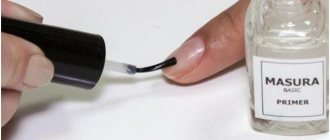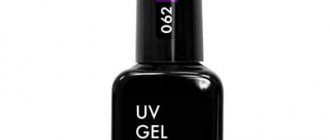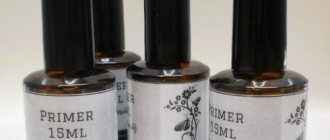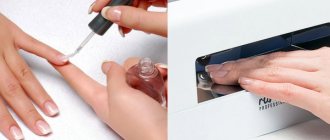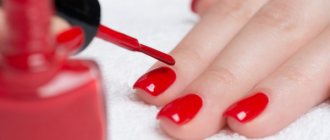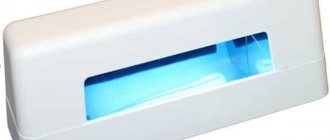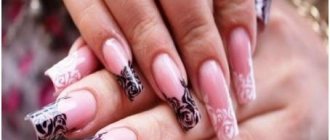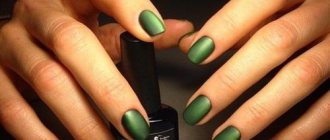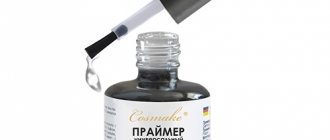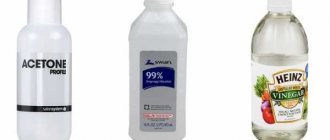The procedure of manicure and application of gel polish is quite popular today, which is why it is worth familiarizing yourself in detail with the products that are used in the process. Masters prefer acidic and acid-free primers, which prepare the nail plate for work. As a result, the question arises, which primer for gel polish is better: acidic or acid-free? In this article we will talk about all the features of these tools, and also answer frequently asked questions.
What is an acid-free primer?
An acid-free primer is a means for degreasing the nail plate, which is also used to increase the adhesion of the nail and the material. Thanks to this product, the final result is preserved for a longer time; the integrity of the coating is not distorted even with prolonged wear.
There are many advantages of an acid-free primer, we note:
- The nail plate is not susceptible to negative effects, even with prolonged walking;
- You can prevent the occurrence of peeling of the nail plate;
- A very convenient and affordable product to use;
- Durability.
Interesting! It is the acid-free primer that does not destroy the nail plate, but deeply degreases it, allowing the gel polish to lie perfectly evenly on the surface and be fixed for a long time.
The acid-free primer contains useful and safe components, which is why many people prefer it.
Scope of application of acid-free primer
Acid-free primer is used mainly at the time of coating nails with gel polish or during extensions. It is he who prepares the nail plate for the rough effects of the base coat, as well as for applying the product itself.
Experts do not recommend using a primer to create a home manicure without using gel polish or extension gel. For regular polish, the effect of the primer will not be 100% visible; the nails may still be brittle, not guaranteeing a tenacious bond between the nail plate and the polish.
Why do you need a nail primer?
The primer is widely in demand in professional salons and when doing manicure work yourself.
Depending on the type of work and materials, specialized liquids vary somewhat, but the main tasks for all types are the same:
- guarantees comprehensive protection of the natural nail plate from the appearance of yellow plaque, peeling, and the formation of fungal microflora;
- By avoiding the use of a primer, there is a likely risk of a “greenhouse effect” appearing between the natural and artificial nail plate. This entails the formation of harmful microorganisms under extended nails;
- effective gluing of the extended surface. The durability of the manicure depends on the quality and reliability of the primer;
- functional degreasing of the nail before extensions.
Don't miss the most popular article in the section: How to draw monograms on nails step by step for beginners. Instructions with photos.
What is an acid primer?
An acid primer is a nail strengthener that contains a small amount of methacrylic acid. These are quite toxic and poisonous substances that greatly dry out the nail, allowing good adhesion between the nail and the gel.
Important! The use of an acid primer is only appropriate if the nail plate is excessively oily. Its use is contraindicated for girls with a dry surface, as this can lead to excessive dryness.
Many people are interested in the question of how to distinguish an acidic primer from an acid-free one? There is only one answer: you need to read the instructions provided in detail, as well as the ingredients. If the goal is to choose an acidic primer, it must contain acid, which will ensure complete drying of the nail plate.
What is acid primer used for?
The difference between acidic and acid-free primers is obvious, and the answer can be seen in the very name of the product. But what is the difference between an acidic primer and an acid-free one, and how does the scope of application depend on this?
As already described above, acid primers are appropriate to use only for girls whose nail plate is characterized by increased fat content, which resists the tenacious adhesion of gel polish and nails. The instant drying effect is visible on the face, because in a matter of seconds the nail plate is covered with a so-called film, which guarantees dryness and safety for the nail during exposure to the components of the gel polish or extension gel.
What is the difference between an acidic primer and an acid-free one?
Having learned that there are two types of primers, many people have a question: what is the difference between an acidic primer and an acid-free one, and which option is best to use in the process? The very first difference is the composition of the products, namely, the presence or absence of acid, which is responsible for additional instant drying of the nail plate.
In addition, other differences between acidic and acid-free primers can be noted:
- The acidic product is recommended for use only by girls who have extremely oily nail plates;
- The acid primer ensures strong adhesion of the material and the nail, as a result of which the gel polish lasts much longer;
- An acid primer is applied primarily under acrylic nails, but an acid-free primer is used for gel extensions;
- An acid-free primer is a universal product, it is suitable for any nail plate, it is recommended even for girls with weak and flaky nails, which cannot be said about an acid primer. Its purpose is exclusively to increase the oiliness of nails;
- An acid-free primer affects the surface only after the base color coat has been used and is not effective in its pure form.
Another simple way to determine which product is used during the manicure process: an acidic primer leaves behind a noticeably white tint after drying, but this is not observed after using an acid-free product.
Which primer is better: acidic or acid-free?
Due to their characteristics, acidic and acid-free primers are popular. Some products have more, others have less. Due to this, many are interested in which option is better before applying gel polishes, and which option should be preferred.
The choice will depend directly on the goal, which is why it is worth considering the features of the two options in more detail.
Acid primer:
- Used to treat damaged and brittle nails;
- Used before applying shellac, gel, acrylic;
- The composition contains methacrylic acid;
- Sometimes negative reactions of the nail plate may occur, which is why it requires a thin application to the nail;
- It is characterized by a pungent odor, so when using it you need to wear special masks on your face.
Acid-free primer:
- Suitable for use before applying gel polish, shellac or extensions;
- Just like acidic, it is used for damaged nails, providing them with density after application;
- There are no acids in the composition, only ethyl acetate is present;
- Dries quickly, has an unpleasant odor;
- It is gentle on any type of nails.
In most cases, experts prefer an acid-free primer, because it copes with all the necessary tasks, and is also ideal for every girl and does not cause allergic reactions.
Comparative characteristics
| Primer | Base | |
| Operating principle | Eliminates moisture and fat from nails, protects the coating from damage (cracks, detachments) and fungal penetration, improves adhesion to colored coating | Leveling the nail surface, preparing the “base” for better application of the decorative coating and long-term wear. |
| Structure | Transparent product with light texture | A thick transparent product, reminiscent of varnish or a light-textured, liquid composition (depending on the type of base) |
| Application | When modeling with gel, acrylic, applying shellac | When creating any artificial coating, as well as before applying classic varnish |
| Active substance | Ethyl acetate/methacrylic acid | Oligomers and monomers (form a polymer) |
| Toxicity | Depends on the type of product (acidic - yes, acid-free - low toxic) | No |
| Sticky texture | No | No |
| The need for drying under a UV lamp | No | Yes |
| Ability to normalize pH balance | Yes (acid free) | No |
How to apply primer correctly?
In order for a manicure primer to give the desired results, fully strengthen your nails and provide them with protection, you need to familiarize yourself with the features of its use. Acid and non-acid products have their own application rules, which is why you need to familiarize yourself with them in more detail at the beginning of the manipulation.
Acid primer
The differences between acidic and acid-free primers have already been clarified; they exist not only in the nature of the effect and composition, but also in the methods of application to the surface of the nail plate.
We must remember! The composition contains toxic acid, but it does not negatively affect the nail if you follow all the rules of use.
First you need to prepare your nails; a manicure with all procedures is done first, because after applying the product, any manipulation with a nail file or tweezers is prohibited.
You need to put a little product on the brush and touch it to the middle of the nail so that the primer spreads evenly to all corners. You should not take an excessive amount of liquid, which will flow outside the cuticle and only create inconvenience in use. If you take a small amount of the product, it will take the desired shape and allow you to dry it immediately.
The primer dries well under the influence of ambient heat and air, so 30-40 seconds is enough, and you can move on to the next step - applying the base coat, which is dried in a lamp.
Acid-free primer
The technology for using an acid-free primer is practically the same; first you need to prepare your nails for applying the product. Everyone considers an acid-free primer to be gentle, which is why many problems arise with it during use. Despite the fact that there is no acid in the composition, if there is an excessive amount it can harm the nail plate and dry it out. That is why you need to take the product onto the edge of the brush, and try to cover all 5 fingers of your hand with this minimum amount.
The primer does not leave any traces behind, which is why the nails take their original appearance in a few seconds and are considered ready for applying the base coat.
Subtleties when working with acidic and acid-free primers
Each nail primer has its own subtleties in operation, which you need to familiarize yourself with first.
Both products are toxic substances that are present in the composition in greater or lesser quantities. That is why you need to know about the following important points when working with them:
- The master must wear gloves when working;
- You should not inhale the smell of the primer; it is better to use a special mask;
- Products are applied in a minimal amount and carefully distributed over the entire nail area;
- There is no need to dry them; they dry as quickly as possible even without a lamp.
These subtleties will allow you to carry out the work quickly, efficiently and effectively.
Important! If there are individual allergic reactions to the primer, its use should be replaced with other folk remedies.
Answers to questions from a manicurist
Every woman has a lot of questions when starting to work with an acid or acid-free primer. To get answers to all your questions, read below the answers of a specialist who knows all the intricacies and features of working with these tools, and also boasts extensive experience in this matter.
How to distinguish an acid primer from an acid-free one?
In fact, acidic and acid-free primers are two different products, the differences of which are visible to the naked eye. First of all, you need to familiarize yourself with its composition, and if the word “acid” is present in it, it is 100% only an acid primer. They also have different smells. For example, due to the acid content, an acid primer is characterized by a sharper odor, which not everyone can tolerate without a mask. This is a basic definition that can be noticed even before using it.
If you come to a specialist for a procedure and want to know which version of the product is used, monitor the condition of your nails after applying the primer. If it is acidic, then in a matter of seconds the nails will form a white color, which indicates that a full process of drying the nail plate has occurred. To learn about the difference between acidic and acid-free primers, watch the video:
What do acid and acid-free primers have in common?
Acid primers, just like acid-free primers, have their own characteristics, advantages, disadvantages, and similarities. Let's look at what is common and different between them. Example in the table.
| General qualities | Differences |
| Apply to nails to ensure tenacity of the nail plate and material. | Compound |
| They have a sharply unpleasant odor. | Price |
| There is no need to dry them in a lamp. | Nail color after application |
| Apply a light layer to the nails. | Women's category for use. |
| Does not cause allergies. | Level of impact on nails. |
Do you need a primer for regular nail polish?
Many people actually use primer for regular nail polish, and it gives good results. After applying the product, the nails become denser, do not become brittle, and the varnish itself lasts several days longer than without using it. But in most cases, a primer is necessary specifically for gel polish.
Is it possible to apply gel polish without primer?
If you do not use a primer for gel polish, the effect will be slightly different. The duration of the integrity of the gel will be minimal; nails may become brittle, chipped, or hit. Gel polish requires the use of a primer for greater density and integrity of the nails, which is why you need to take care of its availability in advance.
Description
Acid primer for strong adhesion of the material to the nail plate, is economical to use, provides reliable coverage and healthy nails, eliminating the occurrence of fungal infections.
Strong foundation
Codi acid primer is the basis for strong adhesion of the nail plate and artificial coating. The product provides simple and safe modeling of acrylic and gel nails. Thanks to it, the coating lies flat, eliminating the occurrence of cracking and peeling.
Reliable composition
Innovation and modern technology have not bypassed this product either. Primer Kodi perfectly degreases the surface of the nail, preparing it for applying the base. In addition, the product has a disinfectant effect, opens the scales of the top layer for the strongest possible adhesion of the nail and the artificial material.
Instructions for use
Push back the cuticle with a pusher or an orange stick, treat the nail with a file, removing the shine (pay special attention to the areas near the side ridges). Brush off sawdust dust with a stiff brush. Apply a layer of primer to the nail plate as follows: put a small amount of product on the brush, squeeze it on the edge of the bottle, and then on a napkin. Apply to the center of the nail, allowing the product to spread evenly over the surface.
In this case, the drug should not flow onto the cuticle and periungual skin (if it accidentally gets there, be sure to rinse the skin with plenty of water, preferably running water). A very thin layer of primer will not only minimize the likelihood of the product getting on the skin, but will also ensure that the product works well (primer applied too thickly can prevent the nail scales from lifting). Wait a couple of minutes, allowing the primer to dry or air dry. After this, you can begin extensions and gel polish coating.
Every manicurist knows that before applying base and gel polish, nails need to be disinfected and their adhesion to the coating increased. This is the only way to get a durable varnish coating and protect your nails from fungal infections. For this, two products are used: acidic and acid-free primers. Which is better? Read about it in our article.
What is Kodi acid primer and how harmful is it?
Cody's acid primer is used during nail extensions. This drug:
- degreases nails
- has a disinfecting effect
- prevents fungal infections
- enhances the adhesion of the coating to the nail
- prevents cracking and peeling of the coating.
The main component of the Kodi acid primer is methacrylic acid, like most primers of other varnish brands. Many are afraid of it and even call it a deadly substance. In fact, this substance, of course, is not useful, but it is also no more harmful than lauryl sulfate in shampoos or acetone.
The only thing worth remembering is that methacrylic acid irritates the mucous membranes, so it is better not to come into direct contact with it and work with glasses and masks.
What is an acid-free Kodi primer and how much better is it than its acidic counterpart?
Ultrabond Kodi is an acid-free primer without methacrylic acid. Its main component is ethyl acetate - ethyl ester of acetic acid. And although this component is no less harmful than methacrylic acid, the Kodi acid-free primer is still more gentle. First of all, it is recommended to use it for dry, thin and brittle nails.
Ultrabond Kodi is applied to dry nails after disinfection. Liquid like water, it dries without drying in a UV lamp in just 1-2 minutes.
What is the difference between acidic and acidless Kodi primer
Both acid primer and ultrabond contain harmful substances, but in acid-free primer they have a low evaporation rate, which is why they are considered less harmful. Also, it is worth noting that Kodi Ultrabond dries your nails less.
Which of these tools to choose is up to you. You can buy Kodi primers in the World of Cosmetics store.
Even women with short nails have the opportunity to boast of an impressively designed manicure done on extended nail plates. For this procedure, manicurists use a product called a primer - a specially developed primer for artificial nail extensions.
Nail primer (gel polish) is an important element of an ideal manicure.

